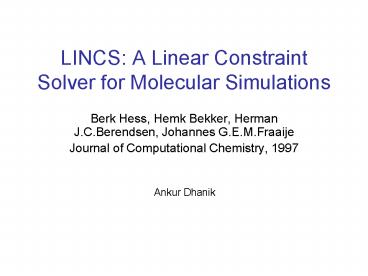LINCS: A Linear Constraint Solver for Molecular Simulations PowerPoint PPT Presentation
Title: LINCS: A Linear Constraint Solver for Molecular Simulations
1
LINCS A Linear Constraint Solver for Molecular
Simulations
- Berk Hess, Hemk Bekker, Herman J.C.Berendsen,
Johannes G.E.M.Fraaije - Journal of Computational Chemistry, 1997
Ankur Dhanik
2
Outline
- Introduction to Molecular Dynamics
- Problem description
- Some solutions
- LINCS
- Results
3
Introduction to Molecular Dynamics
- A classical molecular simulations method
- Successive configurations of the system are
generated by integrating Newtons laws of motion - Integration algorithms should strive to reduce
computation and conserve energy - Various integration algorithms
- Standard Verlet algorithm
- Leap-frog algorithm
4
Introduction to Molecular Dynamics
- Standard Verlet Algorithm
- r(t?t) 2r(t) - r (t-?t) ?t2a(t)
- v(t) r(t?t) - r(t-?t)/2?t
- Velocities are not directly generated, and are
one time step behind - Leap-frog algorithm
- r(t?t) r(t) ?tv(t?t/2)
- v(t?t/2) v(t-?t/2) ?ta(t)
- v(t) v(t?t/2) v(t-?t/2)/2
- Velocities are half time step behind
5
Introduction to Molecular Dynamics
- Choosing the time step
- One order of magnitude smaller than the shortest
motion (bond vibrations) - Severe restriction as these high frequency
motions have minimal effect on the overall
behavior of the system - Constrained dynamics
6
Introduction to Molecular Dynamics
System Type of motion present Suggested times step(s)
Atoms translation 10-14
Rigid molecules Translation and rotation 5 X 10-15
Rigid molecules, rigid bonds Translation, rotation, torsion 2 X 10-15
Rigid molecules, flexible bonds Translation, rotation, torsion, vibration 10-15or 5 X 10-16
The different types of motion present in various
systems together with suggested time steps
7
Introduction to Molecular Dynamics
- In constrained dynamics bonds and angles are
forced to adopt specific values throughout a
simulation - Constraints are categorized as holonomic and
non-holonomic. - Suppose a particle on the surface of a sphere
- r2 a2 0 Holonomic
- r2 a2 gt 0 Non-holonomic
- In a constrained system
- Particles are not independent
- Magnitude of constraint forces are unknown
8
Introduction to Molecular Dynamics
- Integration algorithms
- Standard Verlet Algorithm
- Leap-frog algorithm
- Choosing time step
- Constrained dynamics
- Holonomic and non-holonomic constraints
9
Outline
- Introduction to Molecular Dynamics
- Problem description
- Some solutions
- LINCS
- Results
10
Problem Description
- Design an algorithm for solving constrained
molecular dynamics, the constraints being
holonomic - The algorithm should strive for following
features - Numerical stability
- Energy conservation
- Computational efficiency
11
Some solutions
- Reset coupled constraints after an unconstrained
update - Non-linear problem
- SETTLE
- Solves analytically
- Very fast, but unsuited for large molecules
- SHAKE
- Iterative method
- Sequentially all the bonds are set to the correct
length - Simple and numerically stable
- No solutions may be found when displacements are
large, difficult to parallelize
12
Some solutions
- EEM
- The second derivatives of constraint equations
are set to zero - All the constraints are dealt with simultaneously
- Corrections are necessary to achieve accuracy and
stability
13
LINCS
- Does an unconstrained update
- Sets the projection of the new bonds onto the old
directions of the bonds to the prescribed lengths - Similar to EEM, with some practical differences
- Implements
- Efficient solver for the matrix equation
- A velocity correction that prevents rotational
lengthening - A length correction that improves accuracy and
stability
14
LINCS
15
LINCS
Newtons equation of motion
(I-TB) is projection matrix which sets the
constrained coordinates to zero. T transforms
motions in the constrained coordinates into
motions in cartesian coordinates
16
LINCS
17
LINCS
- Numerical errors can accumulate which leads to
drifts
Velocity correction
Position correction
- Drawback the projection of the new bonds onto
the old directions rather than the new bonds are
set to prescribed lengths
18
LINCS
- Correction for rotational lengthening
- To correct rotation of bond i, the projection of
the bond on the old direction is set to
- The corrected positions are
19
LINCS
Constrained new position is given by
20
LINCS
- The first power of An gives the coupling effects
of neighboring bonds - The second power gives the coupling effect over a
distance of two bonds - The inversion through a series expansion makes
parallelization easy - In one timestep, the bonds influence each other
when they are separated by fewer bonds than
highest order in expansion
21
LINCS
- Parallelization
- Consider a linear-bond constrained molecule of
100 atoms to be simulated on a dual processor
computer - Uses rotation correction and an expansion to the
second power of An - Because order of expansion is two, bonds
influence each other over a distance of 6 - Update of position and call of LINCS algorithm
must be done for atom 1-56 and 44-100 on
processors 1 and 2 respectively - 1-50 update from processor 1 and 50-100 from
processor 2
22
Results
23
Results
- Solves constrained molecular dynamics
- Numerically stable
- Conserves energy
- Three to four times faster than SHAKE
- Can be easily parallelized

